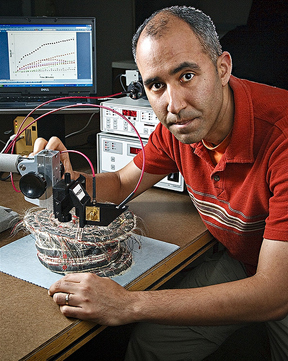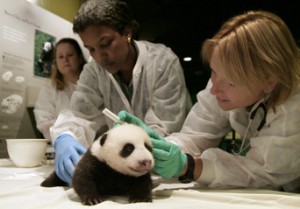From the Secretary: Telling the stories of the Smithsonian
The Smithsonian Institution is known worldwide for our vast and varied collections: diamonds and dinosaurs, pandas and presidential portraits. That’s the easy part. More difficult is helping the public and our other stakeholders understand the remarkable research behind the collections.

Marc Seid, a researcher at the Smithsonian Tropical Research Institute working in the Neurobiology Laboratory led by scientist William T. Wcislo, focuses his research on how the behavioral repertoire of individual ants changes according to age and colony needs. Seid correlates differences in repertoire size and composition to the neurochemistry and neuroanatomy of individual ants. (Photo by Marcos Guerra)
Early in its history, the Smithsonian was the principal scientific institution for the federal government. Over time, dozens of government agencies with research missions emerged, along with upwards of 200 research universities. Smithsonian scientists once bred animals on the National Mall and studied the sky with telescopes near the Castle—work now conducted at the Zoo’s Conservation and Research Center in Virginia and the Harvard-Smithsonian Center for Astrophysics in Cambridge. Through my visits to our other scientific facilities in Maryland, Florida, Panama and elsewhere, I know that science at the Smithsonian is thriving.
I have also spent time behind the scenes in our museums, conservation centers and archives, and it is clear that our research is also the lifeblood of what we do in the arts, history and culture. Our scholarship and research form the common thread that weaves together all our parts into a single great Institution.
Everywhere one turns, exciting work is going on. At the Portrait Gallery, five years of research have culminated in a fascinating exhibition and catalog about the influence of flamboyant artist Marcel Duchamp on the art of portraiture. Drop by the American History Museum’s “On the Water,” a large exhibition on the U.S. maritime industry built on 10 years of research. Visit our conservation laboratories and hear material scientists and conservators describe their research into methods to preserve priceless treasures.

Julio del Hoyo, a researcher at the Smithsonian Museum Support Center in Suitland, Md., uses a micro-fading tester to examine a hat from the Ugandan people of Africa. (Photo by Ken Rahaim)
One of our principal challenges is to maintain the research capacity that the Smithsonian needs to fulfill its role into the future. To help us obtain necessary funding, we must explain to the public and our stakeholders what is really required for the Smithsonian to continue to be the Smithsonian.
How can we get our message out? We must be creative because the traditional media are not always attracted to covering research. I have tried to highlight Smithsonian research in my speeches, interviews and columns to remind the public that we are more than our museums. We also will continue to convene and publicize important symposia on international issues such as the one we hosted last winter, “Tropical Extinction: Will the Rain Forests Survive?”
The Office of Public Affairs is developing a new media strategy. Our research stories increasingly will go directly to the public using Web technologies and outlets such as You Tube. Our home page now includes a new “Smithsonian Science” Web site featuring behind-the-scenes research and videos. OPA has been holding special press briefings on specific topics, such as climate change and invasive species, that have been well attended and have resulted in more media coverage.
The Smithsonian Channel is reaching millions of households through participating cable and satellite companies. The fall 2009 line-up includes programs related to the work of Folklife, Folkways Recordings, the Latino Center, and the Air and Space Museum’s archives. “Accordion King” follows a fierce musical competition in Colombia’s northern Magdalena Valley; “Animals Aloft” tells the stories of flying aces and animals; “Worlds of Sound” traces Folkways Recordings, from its founding by Moses Asch through the folk-singing legends of the 1960s; and the series “Stories from the Vaults” focuses on collections and curators.

From left, The National Zoo's head veterinarian Dr. Suzan Murry; Lisa Stevens, curator, Giant Pandas and Primates; and animal keeper Nicole Mess examine giant panda cub Tai Shan. (Photo by Jessie Cohen)
Finally, the Center for Education and Museum Studies’ online education conferences are sharing our resources worldwide. Thousands of teachers and students in 75 countries participated in the first conference highlighting our Abraham Lincoln-related exhibitions, collections and scholarship. The next online conference—on global climate change—will take place Sept. 29 to Oct.1. Participants will interact with Smithsonian ecologists, tropical biologists and paleontologists, and take virtual fieldtrips to learn about this critical global issue.
There are fascinating stories of Smithsonian research yet to be told. We are determined to do our best to share them.
Wayne Clough is the 12th Secretary of the Smithsonian Institution.
Posted: 1 August 2009
- Categories:



